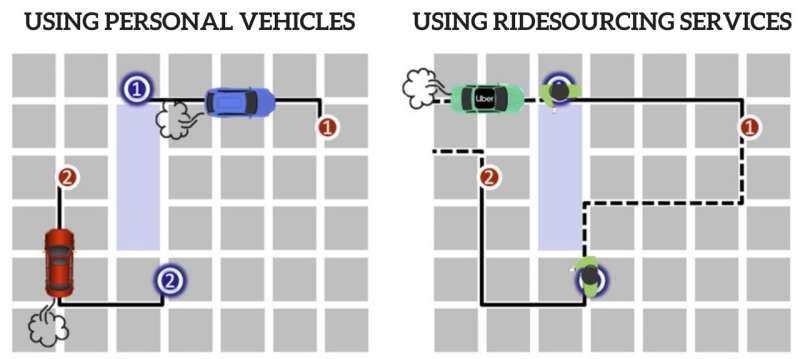Compared to personal vehicle travel, ridesourcing services may reduce emissions from vehicle startups but increase vehicle distance traveled displacement. Credit: Uber and Lyft in U.S. Cities: Findings and Recommendations from Carnegie Mellon University Research on Transportation Network Companies (TNCs) (2022).
Over the last decade, the meteoric rise of ridesourcing services like Uber and Lyft have transformed the urban landscape, affecting travel patterns, car ownership, and congestion, and more broadly, the economy, the environment, and equity.
The ways in which Uber and Lyft are redefining mobility is the focus of a new policy brief series, Uber and Lyft in U.S. Cities: Findings and Recommendations from Carnegie Mellon University Research on Transportation Network Companies (TNCs).
The brief series, a compilation of studies conducted by Jeremy Michalek, the lead author, and other Carnegie Mellon Engineering researchers, delves into the implications and opportunities that TNCs present.
"It is important for us to understand whether TNCs are providing social benefits and whether cities should have a friendly or more skeptical posture toward them," says Michalek, professor of engineering and public policy and mechanical engineering.
On the plus side, the researchers found that TNCs have increased economic growth, employment, and wages for intermittent jobs in U.S. cities.
"However, Uber and Lyft affect different kinds of cities differently, and that is important to understanding their impact," explains Michalek.
For example, TNCs are not a reliable way to reduce car ownership. When TNCs entered U.S. cities, car ownership increased in car-dependent and slow-growth cities, and TNCs displaced transit ridership most in cities with high income and fewer children.
The costs that Uber and Lyft impose on cities are not clear-cut, either. The research reveals that Uber and Lyft can clean the air but clog the streets. Taking an Uber instead of a personal vehicle can reduce air pollution costs by 9 to 13¢, but the extra driving to and from passengers increases costs from congestion, crash risk, and climate change by about 45¢. "You create lower external costs to society when you drive your personal vehicle, on average," says Michalek.
Responding to environmental concerns and public interest, Uber and Lyft have committed to electrify more vehicles in the future, but policy interventions to encourage electrification of TNC fleets may still be warranted. The researchers conducted simulations and found that when TNCs are faced with the air emissions costs that their fleets impose on society, they electrify more of their fleets. This was shown to reduce air emission costs by 10% in New York City and up to 22% in Los Angeles. The researchers note that the best fleet is typically a mix of electric and gas-powered vehicles.
Finally, the brief considers the capacity for Uber and Lyft to reveal and potentially address societal inequities. In one study, the researchers examined TNC ridership during heatwaves in New York City in 2019 and found that ridership increased more in high-income neighborhoods than in low-income neighborhoods, suggesting that low-income riders are subject to endure more extreme heat and humidity.
"We've been doing a lot of work on Uber and Lyft over the past six years, and this brief series provides a compact summary of what we have learned and what we recommend–both for cities and for travelers wishing to reduce negative effects of their travel choices on society," says Michalek.
More information: Brief series: www.cmu.edu/traffic21/research … ers/cmu-policy-brief—-uber-and-lyft-in-us-cities.pdf
Provided by Carnegie Mellon University
























